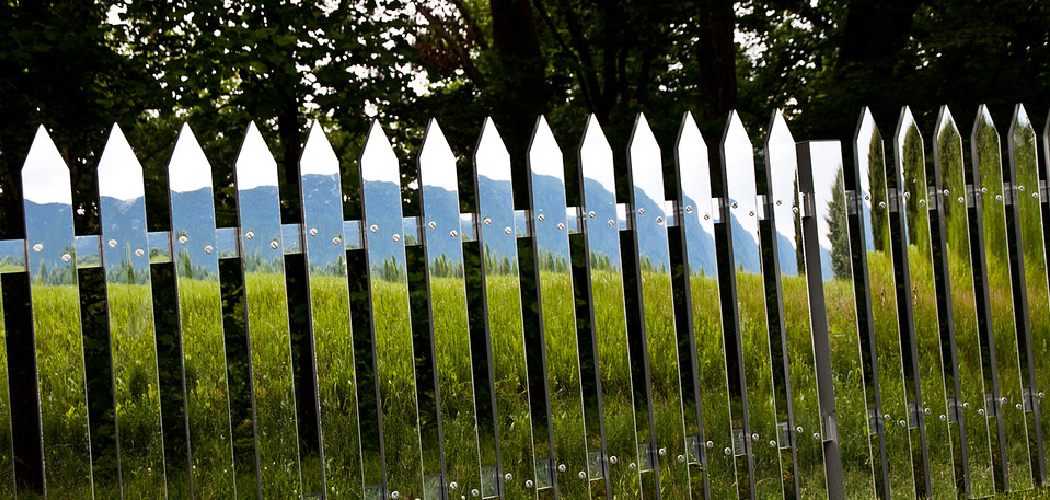Installing an aluminum fence is a rewarding and practical endeavor that combines durability, security, and aesthetic appeal. Whether you’re looking to enhance the curb appeal of your property or establish a secure boundary, the process of installing an aluminum fence is approachable for both DIY enthusiasts and homeowners.
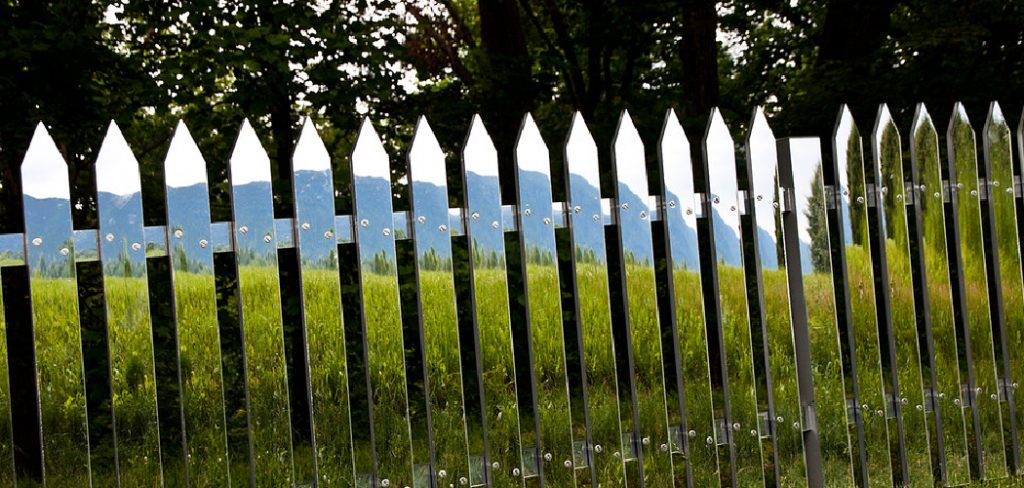
In this article, we will explore the step-by-step guide on how to install an aluminum fence, providing valuable insights into the necessary preparations, measurements, and assembly techniques. From selecting the right materials and determining the fence layout to securing posts and attaching panels, this guide aims to empower individuals with the knowledge required to successfully complete an aluminum fence installation.
Join us on this informative journey as we delve into the intricacies of the installation process, ensuring a sturdy, visually pleasing, and enduring addition to your outdoor space.
Benefits of Aluminum Fencing
Aluminum fences provide an exemplary blend of strength, style, and functionality, making them an increasingly popular choice for both residential and commercial properties. One of the foremost advantages of aluminum fencing is its durability. Unlike wood or iron, aluminum does not succumb to rust, decay, or fading, ensuring it remains visually appealing and structurally sound for years to come.
Additionally, aluminum fencing offers a versatile range of design options, with various colors, styles, and sizes available to complement any landscape or architecture. Maintenance is another area where aluminum fences excel, requiring minimal effort to keep them looking pristine.
Finally, the ease of installation is a significant benefit, as aluminum fence panels and posts are lightweight and designed to fit together efficiently, reducing the time and labor associated with setting up. Together, these benefits make aluminum fencing a cost-effective, attractive, and hassle-free choice for enhancing security and aesthetic appeal.
Why Homeowners Choose Aluminum Fencing
Homeowners gravitate towards aluminum fencing for its unparalleled combination of functionality and aesthetic charm. This fencing option not only elevates the visual appeal of a property but also provides a robust layer of security without the maintenance headaches associated with other materials.
Aluminum’s resistance to corrosion means that it stands up admirably against harsh weather, retaining its original appearance without necessitating frequent touch-ups or repairs. This longevity, coupled with the availability of a diverse array of designs and colors, allows homeowners to tailor their fencing to perfectly match their home’s exterior and landscape, making aluminum fencing a versatile choice for any property style.
Additionally, for those conscious about the environment and sustainability, aluminum is a highly recyclable material, further enhancing its appeal to the modern homeowner.
Reasons for Choosing Aluminum as A Fencing Material
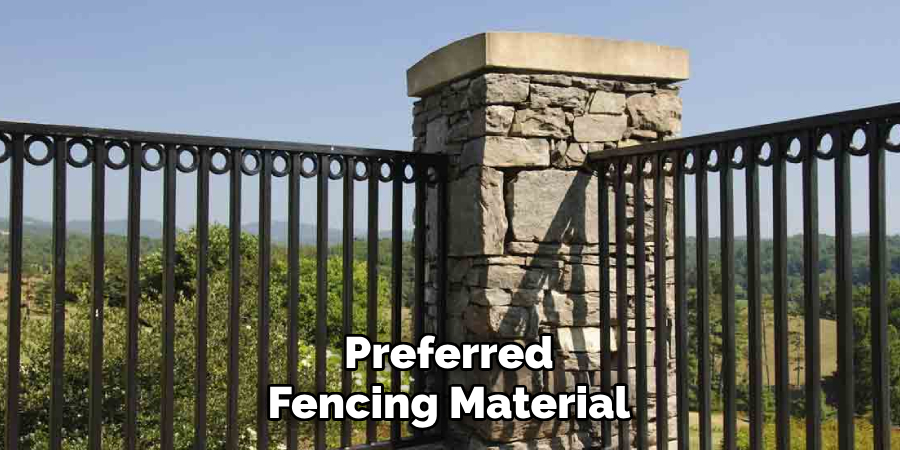
Aluminum stands out as a preferred fencing material due to its unmatched blend of durability, design versatility, and environmental friendliness. Its inherent resistance to corrosion means it is an ideal choice for areas prone to inclement weather, ensuring the fence remains attractive and maintenance-free for years. Beyond its resilience, aluminum offers exceptional flexibility in design.
Manufacturers provide a wide selection of styles, from traditional picket fences to more modern, sleek designs, allowing homeowners to find the perfect match for their aesthetic preferences.
The material is also lightweight, which simplifies the installation process, making it accessible for DIY projects and reducing installation costs. Furthermore, aluminum’s eco-friendly nature is a significant draw for environmentally conscious consumers.
Being 100% recyclable, it offers a sustainable fencing option that minimizes environmental impact without compromising on strength or beauty. Collectively, these factors position aluminum fencing as a superior choice for homeowners seeking a long-lasting, appealing, and sustainable boundary solution for their property.
Planning and Design
Before you begin the physical installation of your aluminum fence, thorough planning and design are crucial to ensure the project’s success and compliance with local regulations. Start by determining the primary purpose of your fence, whether for security, privacy, or aesthetic enhancement, as this will influence the design and type of fence you choose.
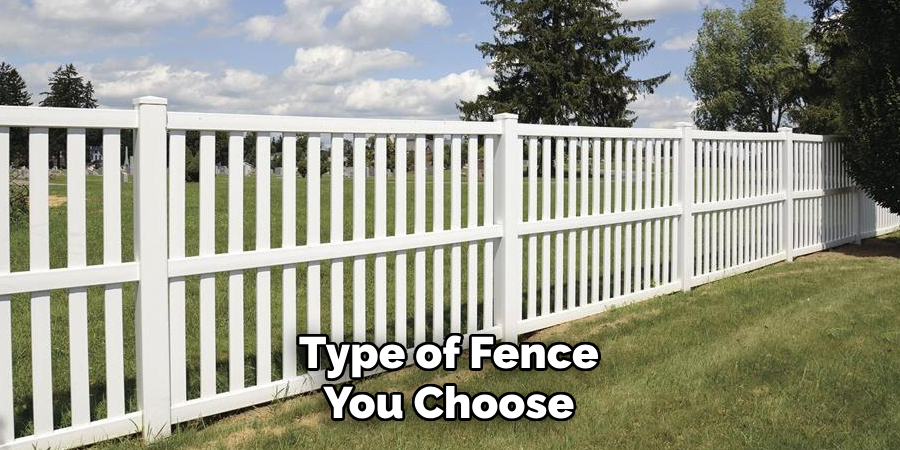
Next, carefully measure the area where the fence will be installed to calculate how much material you will need and to identify any potential obstacles such as trees or uneven terrain that may affect the installation process.
It’s essential to consult with local zoning offices to obtain necessary permits and to understand any property boundary laws or homeowner association regulations that may apply. Marking the location of underground utilities is also a critical step to prevent damage and ensure safety during the installation.
Once the logistical aspects are addressed, you can focus on the design of the fence. Consider the height, color, and style of the aluminum fence that best complements your property’s exterior and landscape. Many manufacturers offer customizable options, allowing you the flexibility to create a fence that truly reflects your personal taste and enhances the overall appearance of your property.
By meticulously planning the design and understanding the legal and practical considerations, you can lay a solid foundation for a smooth and successful aluminum fence installation project.
The Purpose of The Fence
Identifying the primary purpose of your aluminum fence is a critical step that should not be overlooked. This purpose not only influences the design and dimensions of the fence but also affects various aspects of the installation process.
For instance, if the fence is intended for security purposes, you might prioritize height and durability, possibly incorporating features such as spikes or a more robust locking mechanism. Conversely, if privacy is the main goal, selecting panels with minimal gaps between the pickets becomes essential.
Meanwhile, an aluminum fence installed primarily for aesthetic reasons can focus more on design elements, allowing for more creativity and stylistic choices. Regardless of the purpose, understanding what you aim to achieve with your fence ensures that the final installation meets all your needs and expectations, enhancing the functionality and appearance of your property.
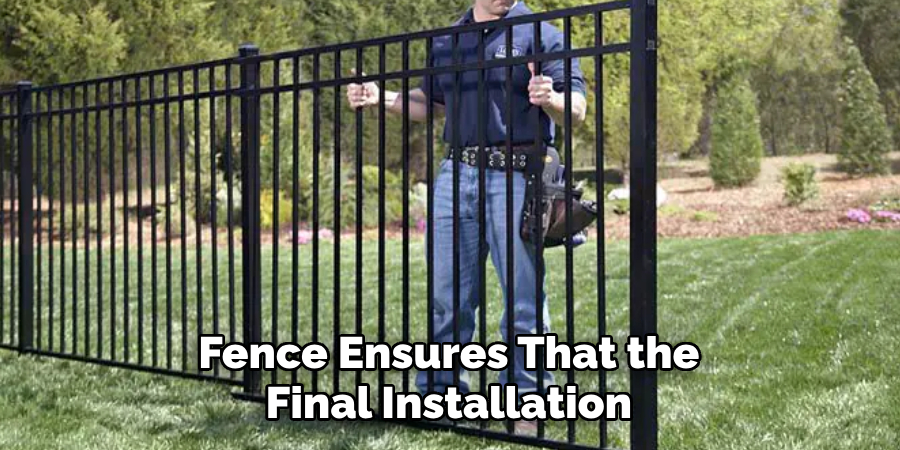
Navigating Permits and Building Codes
Before embarking on the installation of an aluminum fence, it’s imperative to address the legal requirements such as obtaining the necessary permits and adhering to local building codes.
These regulations are in place to ensure that construction projects meet safety standards and that they do not infringe upon public or private boundaries. The process typically involves submitting a detailed plan of your proposed fence to the local building authority, which may include the fence’s height, design, and location relative to your property line.
Local building codes can vary significantly depending on the municipality, and they often dictate specifics such as the maximum fence height, setback from property lines, and even the materials that can be used. Being informed and compliant with these rules from the outset can prevent costly modifications or legal issues down the line.
In addition to understanding and adhering to building codes, securing the proper permits before starting construction is crucial. This usually requires a fee and possibly a review period by the local authorities.
While this might seem like an additional hurdle, it serves as a protection for homeowners, ensuring that the fence is structurally sound and legally compliant. Failure to obtain the necessary permits can result in fines, mandated removal of the fence, or complications when trying to sell the property.
10 Methods How to Install an Aluminum Fence
1. Plan and Measure:
Begin by planning the layout of your aluminum fence and measuring the dimensions of the area you wish to enclose. Consider property lines, slopes, and any obstacles that might affect the fence’s placement. A well-thought-out plan ensures a smooth installation process.
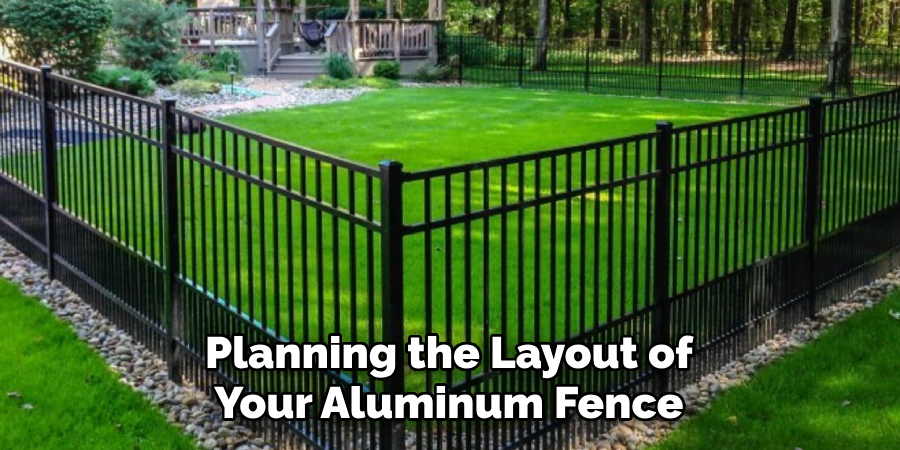
Next, carefully measure the length and width of the area where you want to install the fence, taking into account any changes in terrain or slopes. Use measuring tools such as a tape measure or laser level for accuracy. This information will help determine how much fencing material is needed.
When planning your fence layout, also consider the height of the fence. If you have pets or small children, a taller fence may be necessary for safety purposes. Additionally, check with your local building codes to ensure you are following any height restrictions.
2. Gather Materials and Tools:
Once the layout is determined, gather all the necessary materials and tools for the project. This typically includes aluminum fence panels, posts, gate hardware, concrete for post installation, a level, measuring tape, and a saw. Ensure you have everything on hand before starting. It’s also a good idea to have safety gear such as gloves and goggles.
3. Mark Post Locations:
Use stakes and string to mark the locations of the fence posts along the planned layout. This step ensures accurate spacing and alignment of the posts. Consider the size and design of your fence panels when determining the distance between posts. It is important to have evenly spaced posts for stability and aesthetic purposes.
To mark the post locations, first measure and mark the corners of your fence line. Then, using a tape measure or measuring wheel, determine the distance between each corner and evenly space out your remaining post locations. Use stakes to mark these points on the ground.
4. Dig Post Holes:
With the post locations marked, use a post hole digger to excavate holes for the aluminum fence posts. The depth of the holes will depend on the height of the fence and local building codes. Aim for a depth that provides stability and support for the posts. Generally, 2 feet deep is a good rule of thumb.
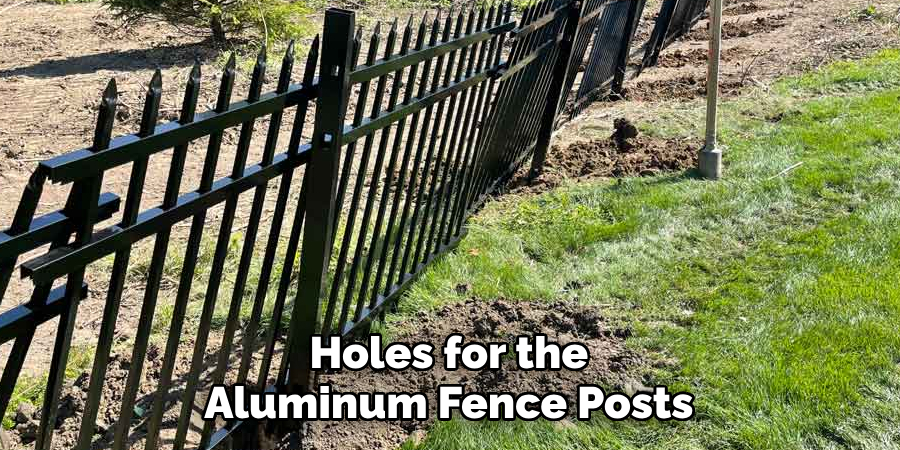
After digging each hole, use a level and a string line to ensure that the holes are all at the same height. This will help keep your fence straight and even. It’s important to take your time with this step, as it will greatly impact the overall look and functionality of your fence.
Once all the holes are dug and leveled, insert the aluminum fence posts into the holes. Use a level to ensure that each post is straight and adjust as necessary. Then, fill the holes with concrete to secure the posts in place.
5. Set and Level Posts:
Once the holes are dug, set the aluminum fence posts into the holes and fill them with concrete. Use a level to ensure the posts are perfectly vertical. Allow the concrete to cure according to the manufacturer’s instructions before moving on to the next steps.
After the concrete has cured, it’s time to add any additional posts needed for your fence. This may include gate posts or corner posts depending on the layout of your fence.
When adding these additional posts, be sure to follow the same steps as before – dig the holes, set the posts, and use a level to ensure they are straight. It is important to maintain consistency throughout the entire fence installation process.
Next, attach any brackets or fasteners needed to secure the posts in place. These can typically be purchased at the same store where you bought your fence panels.
6. Attach Brackets to Posts:
Once the posts are securely set, attach fence brackets to each post. These brackets will hold the aluminum fence panels in place. Ensure the brackets are level and evenly spaced along the posts for a consistent and secure attachment. Use a level to ensure the brackets are straight and adjust as necessary.
Next, insert the panel into the brackets and secure it using a screws. Make sure to use weather-resistant screws for outdoor installations. Repeat this process for each panel until the entire fence is assembled.
7. Install Fence Panels:
With the brackets in place, install the aluminum fence panels by sliding them into the brackets on the posts. Secure the panels with screws or other hardware provided by the manufacturer. Check for proper alignment and adjust as needed. Repeat this process for all panels until the desired length of fence is complete.
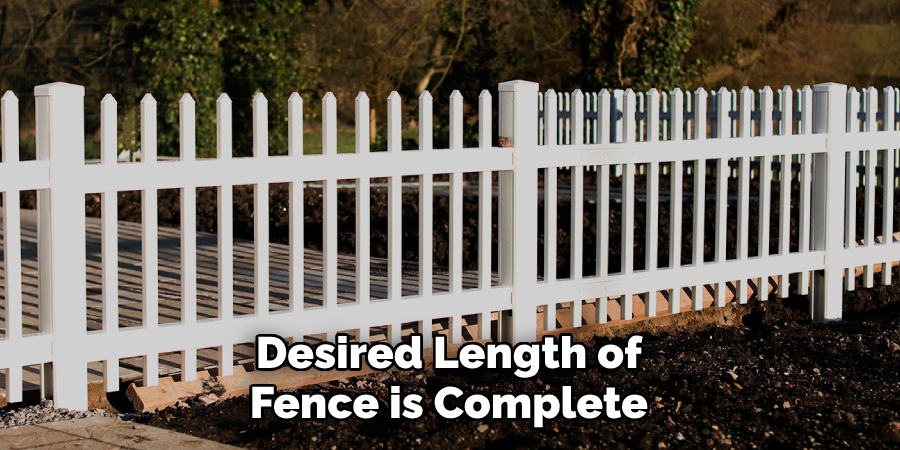
Once the fence panels are installed, add a gate if needed. Gates can be purchased separately or as part of a fence panel kit. Install the gate by attaching it to the adjacent fence panel using hinges and a latch mechanism. Check that the gate swings freely and latches securely.
To give your new fence a polished look, add post caps to the top of each post. These can be found in a variety of styles and materials such as vinyl, wood or metal. Simply place the cap on top of the post and secure with screws if necessary.
8. Install Gates:
If your aluminum fence includes gates, install them according to the manufacturer’s instructions. Attach gate posts securely, ensuring proper clearance and alignment. Check that the gate opens and closes smoothly before completing the installation. If your fence does not include gates, you may choose to purchase and install them separately.
Before purchasing gate hardware, consider the type of gate you need. There are several options available, including single or double swing gates, sliding gates, and rolling gates. Each type has its own unique hardware requirements and installation process.
Single and double swing gates are the most common type of gate for residential fences. They swing open and closed on hinges attached to the gate post. For a single swing gate, you will need two gate hinges, while a double swing gate requires four hinges. Make sure to choose heavy-duty hinges that can support the weight of your gate.
9. Secure End and Corner Posts:
Pay special attention to end and corner posts, as these provide additional support and stability to the fence. Use additional braces or support systems as recommended by the manufacturer to enhance the strength of these critical points.
Additionally, make sure to properly secure the end and corner posts in the ground using concrete or other stable foundations. This will help prevent them from shifting or coming loose over time.
It’s also important to regularly inspect these posts for any signs of damage or wear. Replace any damaged or weakened posts immediately to maintain the structural integrity of your fence.
10. Inspect and Maintain:
After completing the installation, inspect the entire aluminum fence for any issues, such as loose hardware or misaligned panels. Address any issues promptly to ensure the fence is secure and functions as intended.
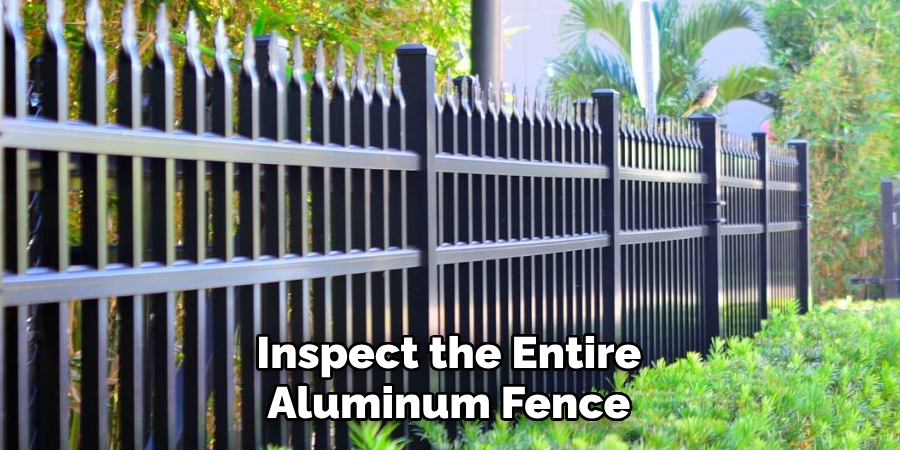
Establish a regular maintenance routine to keep the fence in optimal condition. This includes cleaning the fence with mild soap and water, checking for rust or corrosion, and lubricating any moving parts.
Additionally, regularly inspecting your aluminum fence can help you identify any potential problems before they become major issues. Look for signs of damage from weather, such as fading or warping, and make necessary repairs or replacements.
If your fence is located near saltwater or in a high humidity environment, it is important to wash and rinse the fence more frequently as salt can cause corrosion.
Conclusion
In conclusion, installing an aluminum fence is a rewarding project that enhances both the aesthetic appeal and security of a property. By following the outlined steps and taking the time to plan and prepare properly, homeowners can achieve a professional-looking installation that adds value to their homes.
From marking the fence layout to installing posts, panels, and gates, each step requires attention to detail and precision. The durability and low maintenance nature of aluminum fencing make it an attractive option for many homeowners seeking a long-lasting and stylish solution.
Hopefully, this article gave you some helpful tips about how to install an aluminum fence successfully, so now that you have the proper knowledge on how to get the job done, why not give it a try today?

